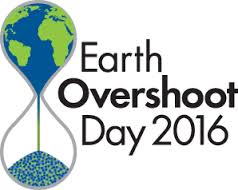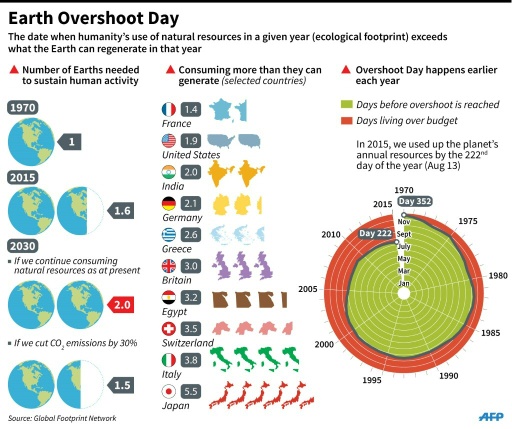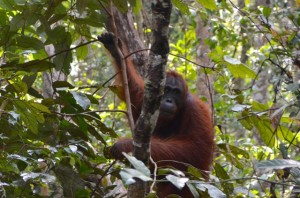Earth Overshoot and Ending Our Debt to Nature
Aug 8th, 2016 | By admin | Category: Consumption and WasteBy Suzanne York.
Most people in the world will blithely go about their lives on August 8th, without knowing that on this day, we go into debt to nature.
Otherwise known as Earth Overshoot Day, it is the day when humanity’s resource consumption for the year exceeds the planet’s ability to replenish its natural capital.
The date we go into planetary overshoot is tracked by the Global Footprint Network, and it has been arriving earlier and earlier with each passing year (in 1993 Earth Overshoot Day was on October 21). According to the organization, Earth Overshoot Day is computed by dividing the planet’s biocapacity (the amount of ecological resources Earth is able to generate that year), by humanity’s Ecological Footprint (humanity’s demand for that year), and multiplying by 365, the number of days in 2015:
(Planet’s Biocapacity / Humanity’s Ecological Footprint) x 365 = Earth Overshoot Day
But all we really need to understand is that we’ve reached the point in the year when we can’t pay off our ecological debt – we have “exhausted nature’s budget for the year.”
Growing Human Influence
As we enter into what many scientists call the “Anthropocene” – the period of Earth’s history during which humans have a decisive influence on the state, dynamics and future of the Earth system – it is undeniable that humans are changing the planet.
New research published in the journal Science states that biodiversity has dropped below the “safe limit” across nearly 60 percent of the Earth’s surface, according to a comprehensive analysis of global data. “We’ve found that across most of the world, biodiversity loss is no longer within the safe limit suggested by ecologists,” said lead researcher Dr. Tim Newbold of University College London.
An extensive study on the state of the global environment recently released by the United Nations Environment Programme (UNEP), the Global Environmental Outlook (GEO-6), concluded that “The environmental change sweeping the world is occurring at a faster pace than previously thought, making it imperative that governments act now to reverse the damage being done to the planet.”
In particular, the UNEP report found, “in almost every region, population growth, rapid urbanization, rising levels of consumption, desertification, land degradation and climate change have combined to leave countries suffering from severe water scarcity.”
We Have the Solutions
The news seems dire, and it certainly is, but some relief can be found in the simple fact that we know what to do. The biggest obstacle is not money, but lack of political will.
If we are able to find the will to change and influence policymakers to enact that change, then there are a few concepts and approaches that can guide us:
Economic growth – conventional economic wisdom holds that global economic growth can continue forever, yet the reality of resource constraints say otherwise. Rethinking economic structures is needed. There are viable alternatives that offer the opportunity to live within the planet’s means, such as steady-state economics and supporting local economies and alternative economic indicators (i.e., Genuine Progress Indicator).
Invest in Women – empowering women won’t end global overshoot but it will make for a better world. An estimated 225 million women in developing nations would like to be able to plan the spacing and timing of their children but don’t have the education, access, knowledge or cultural permission to use a modern method of family planning. Investing in women goes with a more sustainable environment – when women’s needs are met, they are able to better manage resources, confront the effects of climate change and support healthier communities.
Beyond Conservation – many organizations and individuals work tirelessly to conserve species and the natural world. But the fact of the matter is that most national parks and protected areas are becoming oases in a sea of humanity. Bigger picture thinking is needed. Supporting an interconnected approach such as the Population, Health and Environment (PHE) model that links conservation and health efforts is one way. Rights of nature is another path, that attempts to change the view of nature as property to be bought, sold and plundered; it offers real hope for protecting the environment. Otherwise, we are just putting band-aids on conservation efforts.
Planetary Responsibility
In The Anthropocene: From Global Change to Planetary Stewardship, a number of leading scientists address the Anthropocene and where the planet is headed. One sentence in particular really stands out:
We are the first generation with the knowledge of how our activities influence the Earth System, and thus the first generation with the power and the responsibility to change our relationship with the planet.
Perhaps if more people recognized this, we can affect real, positive change and reverse course. It starts with awareness and education on our debt with nature.
For one easy thing to do, take the Pledge for the Planet, and consider how much you consume and begin to change it. We don’t need as much stuff as we think we do, and the planet is paying a high price for that. If we don’t change our consumptive ways, then eventually, we all will pay a high price.
Suzanne York is Project Director of Transition Earth.




[…] it is appropriate that World Elephant Day (August 12) follows Earth Overshoot Day, the date when humanity exceeds the carrying capacity of the […]